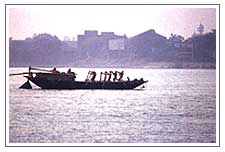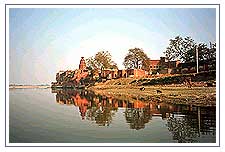The holiest of all the rivers, Ganga or the Ganges is a perennial river,
which is held in high regard by the Hindus. The Ganga river has an exalted
position in the Hindu ethos.

The
Gangotri Glacier, a vast expanse of ice five miles by fifteen, at the
foothills of the Himalayas (14000 ft) in north Uttar Pradesh is the source
of Bhagirathi, which joins with Alaknanda (origins nearby), to form Ganga at
the craggy, canyon-carved town of Devprayag.
Legends & Myths Related To The Ganges or Ganga River
The Ganga has
an exalted position in the Hindu ethos. It is repeatedly invoked in the
Vedas, the Puranas, and the two Indian epics, the Ramayana and the
Mahabharata. Ganga is a goddess, Ganga devi, one of two daughters of Meru
(the Himalayas), the other being Uma, consort of Shiva. In her youth, Indra
had asked for Ganga to be given to heaven to soothe the Gods with its cool
waters. The story of its descent to earth appears in slightly different
forms in Ramayana, Mahabharata and in the Puranas. These myths are variously
dated between 2000 to 400 BC.
The Ganges has many names associated with its many roles in Sanskrit
mythology. Bhagiratha himself is the source of the name Bhagirathi (of
Bhagiratha), which is its initial stream, but is also another name for the
Hooghly. At one point, Bhagiratha went too close to the sage Jahnu's
meditation site, and the disturbed hermit immediately gulped up all the
waters. Eventually, after more persuasion from Bhagiratha, the sage yielded
the waters, but Ganges retained the name "Jahnavi".
Water from the Ganga has the recursive property that any water mixed with
even the minutest quantity of Ganga water becomes Ganga water, and inherits
its healing and other holy properties. Also, despite its many impurities,
Ganga water does not rot or stink if stored for several days.
The Course Of River Ganges & Its Tributries
The Glacier, a vast
expanse of ice five miles by fifteen, at the foothills of the Himalayas
(14000 ft) in Northern Uttaranchal is the source of Bhagirathi, which joins
with Alaknanda to form Ganga at the craggy canyon-carved town of Devprayag.
Interestingly, the sources of Indus and the Brahmaputra are also
geographically fairly close; the former goes through Himachal Pradesh and
fans out through Punjab and Sindh (Pakistan) into the Arabian Sea. The
latter courses for most of its tremendous length under various names through
Tibet/China, never far from the Nepal or Indian borders, and then takes a
sharp turn near the northeastern tip of India, gathers momentum through
Assam before joining the major stream of the Ganga near Dacca in Bangladesh
to become the mighty Padma, river of joy and sorrow for much of Bangladesh.
From Devprayag to the Bay of Bengal and the vast Sundarbans Delta, the
Ganga flows some 1,550 miles, passing and giving life to some of the most
populous cities of India, including Kanpur, Allahabad,
Varanasi,
Patna, and Kolkatta. Dacca, the capital of Bangladesh is on a tributary of
the Brahmaputra, just before it joins the Ganga to form Padma. A large
number of tributaries join and flow from the Ganges to drain the Northern
part of India and Bangladesh.
Yamuna River:

The
Yamuna, which originates less than a hundred miles east of the Bhagirathi,
flows parallel to the Ganga and a little to the south for most of its course
before merging with the Ganga at the holy city of
Allahabad, also
known as
Triveni Sangam, literally, Three-way Junction, the third
river being the mythical Saraswati which is also supposed to be an
underground river. New Delhi, capital of India, and Agra, site of the Taj
Mahal, are two of the major cities on the Yamuna.
The largest tributary to the Ganga is the Ghaghara, which meets it before
Patna, in Bihar, bearing much of the Himalayan glacier melt from Northern
Nepal. The Gandak, which comes from near
Kathmandu, is another big
Himalayan tributary. Other important rivers that merge with the Ganga are
the Son, which originates in the hills of Madhya Pradesh, the Gomti which
flows past Lucknow, and the Chambal made notorious by the ravines in its
valley.
The delta of the Ganga, or rather, that of the Hooghly and the Padma, is a
vast ragged swamp forest (42,000 sq km) called the
Sundarbans, home
of the
Royal Bengal Tiger. The silt-carrying waters of the Ganga
stains the Bay of Bengal a muddier hue for more than 500-km into the ocean.
The rafting
experience of the Ganges starts at a very calm pace and rafters can easily
indulge in some lighthearted racing adventure. But as the rafts approach the
rapids, the riders have to put all their concentration on-board and
manoeuvre the oars in a programmed fashion. Then just as the rafts hit the
first series of the fast-moving water, let the oars go limp and ride the
waves, being tossed up and about, in return.
As the rafter faces more and more stronger rapids, his balancing skills
also grow stronger. But the most surprising fact is, as the raft reaches the
last signpost ahead of Rishikesh, the Ganga suddenly turns calm.
Riding the Ganges is an exhilarating experience and its this apparent
invincible power of this river that has attracted the adventurer to the
challenging sport of river rafting. Even the leading rafting experts say
that Indian rivers have the potential of having some of the most exciting
stretches of white water rafting in the world and the most popular river
rafting choices in India are the Ganga, the Bhagirathi, the Alaknanda.


 The
Gangotri Glacier, a vast expanse of ice five miles by fifteen, at the
foothills of the Himalayas (14000 ft) in north Uttar Pradesh is the source
of Bhagirathi, which joins with Alaknanda (origins nearby), to form Ganga at
the craggy, canyon-carved town of Devprayag.
The
Gangotri Glacier, a vast expanse of ice five miles by fifteen, at the
foothills of the Himalayas (14000 ft) in north Uttar Pradesh is the source
of Bhagirathi, which joins with Alaknanda (origins nearby), to form Ganga at
the craggy, canyon-carved town of Devprayag.
 The
Yamuna, which originates less than a hundred miles east of the Bhagirathi,
flows parallel to the Ganga and a little to the south for most of its course
before merging with the Ganga at the holy city of Allahabad, also
known as Triveni Sangam, literally, Three-way Junction, the third
river being the mythical Saraswati which is also supposed to be an
underground river. New Delhi, capital of India, and Agra, site of the Taj
Mahal, are two of the major cities on the Yamuna.
The
Yamuna, which originates less than a hundred miles east of the Bhagirathi,
flows parallel to the Ganga and a little to the south for most of its course
before merging with the Ganga at the holy city of Allahabad, also
known as Triveni Sangam, literally, Three-way Junction, the third
river being the mythical Saraswati which is also supposed to be an
underground river. New Delhi, capital of India, and Agra, site of the Taj
Mahal, are two of the major cities on the Yamuna.